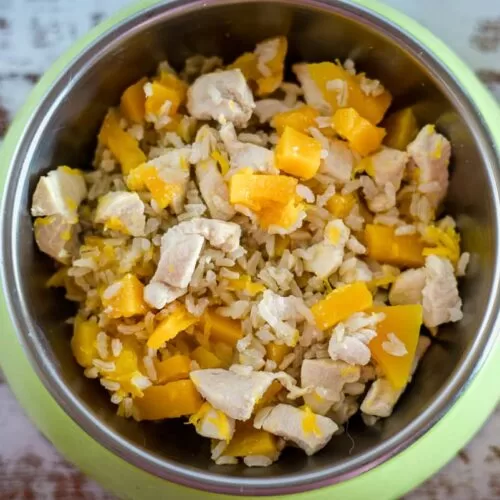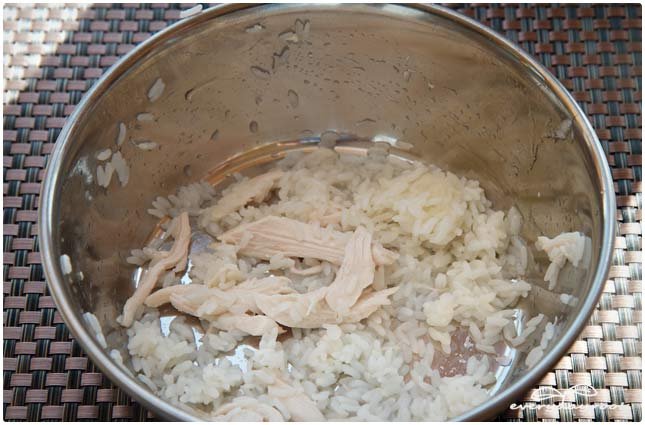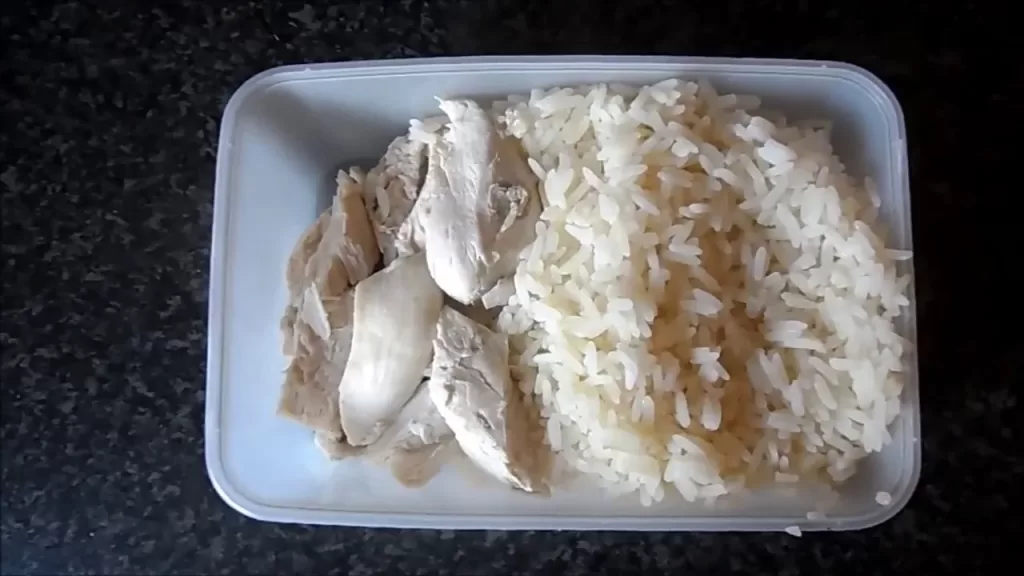Chicken and Rice for Dogs: When your dog is not in good health, it may be advisable to put your puppy on a chicken and rice diet for a few days.
Table of Contents
This is a great way to fix their stomach, restore their appetite and get healthy quickly.
While this may seem like an easy task, most loving foster parents feel misunderstood and suffer without helping their dog friend.

In this article, we will start with everything you need to know about feeding your dog chicken and rice, when, and why.
We will also look at what kind of chicken and rice to use, how to make it, and how much chicken and rice to give your dog by weight.
Finally, we will look at some alternatives to chicken and rice as food for sick dogs and when and why you might want to consider these options.
Chicken and Rice for dogs | When to feed your dog chicken and rice?
Your vet will tell you when to put your dog on a diet of chicken and rice, often referred to as the Blonde Diet.
Your vet usually refers to this food when your dog is:
- Vomiting for six hours or more
- Suffering from persistent diarrhea
- Has severe gas or constipation
- Decreases appetite
- Recovering from surgery or serious illness
Is a Chicken and Rice Diet Good for Dogs?
Canine tummies can sometimes get upset for various reasons. It could be because they ate something they shouldn’t have, or their regular food didn’t agree with them. When dogs have stomach troubles, veterinarians might suggest giving them a “bland diet” of chicken and rice to help them feel better.
Chicken and rice can be beneficial for dogs with upset stomachs when prepared correctly. This combination is easy for dogs to digest and is low in fat. This helps their stomachs get back to normal more comfortably and quickly.
However, it’s important to understand that chicken and rice might not be suitable for all dogs with upset stomachs.
If your dog is vomiting, you should consult with a vet before giving them chicken and rice, according to Dr. Kendra Scheibe, a veterinarian. In some cases, dogs may need a short break from eating to let their stomach settle down.
Some stomach problems in dogs can be more serious, like pancreatitis. In these cases, it’s best to talk to your vet before trying chicken and rice as a remedy for stomach issues.
Once your vet gives the green light, it’s worth knowing that chicken and rice are quite tasty for dogs. This is essential when you want to feed a dog that may not be very hungry due to their stomach problems. The delicious taste of chicken and rice can encourage them to eat, helping their stomach issues to improve.
Chicken and chicken broth contain omega-6 fatty acids and are high in protein but low in fat. Rice is more energy-packed compared to foods like potatoes. So, dogs with tummy troubles won’t need to eat as much to get the energy they need for the day.
The rice’s starch provides glucose that gets absorbed quickly. This is similar to what happens when children have diarrhea. It helps with water and electrolyte absorption, which can reduce the amount of stool and decrease how long diarrhea lasts, meaning fewer IV fluids may be needed.
So, in the right circumstances, a chicken and rice diet can be a helpful option for dogs with upset stomachs. However, it’s always a good idea to check with your veterinarian first to ensure it’s the best choice for your furry friend’s specific situation.
Benefits of Chicken and Rice Diet for Dogs
| Benefit | Explanation |
|---|---|
| Easy Digestibility | Chicken and rice are both easily digestible, making this diet suitable for dogs with sensitive stomachs or digestive issues. |
| Provides Lean Protein | Chicken is a high-quality source of lean protein, essential for muscle maintenance, immune function, and overall health. |
| Gentle on the Stomach | The bland nature of chicken and rice helps soothe the stomach and is often recommended during periods of gastrointestinal upset. |
| Balanced Nutrition | The combination of chicken (protein) and rice (carbohydrates) provides a balanced meal, offering energy and nutrients necessary for a dog’s well-being. |
| Helps in Recovery | It is commonly used post-surgery or during recovery from illness to provide a gentle yet nutritious diet that supports the healing process. |
| Useful for Food Transition | Chicken and rice can be used as a transitional diet when introducing a new food, helping to prevent digestive upset during the transition period. |
| Hydration Support | The moisture content in the boiled chicken and cooked rice contributes to hydration, especially beneficial for dogs with diarrhea or dehydration. |
| Limited Ingredients | A simple recipe with only a few ingredients reduces the risk of allergens or sensitivities and is suitable for dogs with dietary restrictions. |
How Long to Feed Your Dog Chicken & Rice
When your dog has an upset stomach and you’re using a chicken and rice diet to help, it’s usually not for a long time. This special diet is needed for a brief period, and you can usually stop it three to four days after your dog’s tummy trouble is over, and they’re not vomiting anymore. Their stools should also be back to normal.
But don’t rush to switch back to your dog’s regular food immediately.
Once your dog’s stomach issues have gone away, experts recommend a gradual transition back to their normal diet. Here’s how to do it:
- Start by replacing a small portion of the chicken and white rice with your dog’s usual food. You can begin with a quarter or a third of the meal.
- Every day, increase the amount of your dog’s regular food while reducing the chicken and rice portion.
- Keep doing this until your dog is back to eating their regular diet entirely.
This gradual transition helps your dog’s stomach adjust to their usual food again and reduces the chances of upsetting their tummy once more. So, be patient and take it step by step.
Below is a chart and detailed explanation on how long to feed your dog a chicken and rice diet. It’s important to note that this diet is typically used as a temporary measure and not intended for long-term feeding.
Duration Guide for Feeding Chicken and Rice to Dogs:
| Condition or Scenario | Recommended Duration |
|---|---|
| Upset Stomach or Diarrhea | 2-3 Days: Feed chicken and rice until symptoms subside. |
| Post-Surgery or Medical Recovery | As Advised by Veterinarian: Follow vet’s recommendations for recovery. |
| Transition to New Diet | 3-5 Days: Gradually introduce regular dog food alongside chicken and rice. |
| Sensitive Stomach Maintenance | Consult Veterinarian: If recommended for long-term use, determine duration with vet. |
Boiled chicken and rice for dogs

Boiled chicken and rice is a commonly recommended bland diet for dogs, particularly when they are experiencing digestive issues, such as upset stomach, diarrhea, or vomiting. This simple and easily digestible meal is often prescribed by veterinarians to help soothe the digestive system and provide a gentle source of nutrition.
Here’s a clear and detailed explanation of the preparation and benefits of boiled chicken and rice for dogs:
Preparation of Boiled Chicken and Rice for Dogs:
Ingredients:
- Chicken Breast: Use boneless, skinless chicken breast for a lean protein source.
- White Rice: Choose plain, white rice as it is easily digestible for dogs.
- Water: Sufficient water for boiling and maintaining the desired consistency.
Instructions:
- Clean and Cut Chicken: Rinse the chicken breast under cold water to remove any contaminants. Cut it into small, bite-sized pieces.
- Boil Chicken: Place the chicken pieces in a pot, cover with water, and bring to a boil. Once boiling, reduce heat and simmer until the chicken is thoroughly cooked. Ensure there are no pink or raw parts.
- Cook Rice: In a separate pot, cook the white rice according to the package instructions. Cook it until it is soft and easily digestible.
- Combine Chicken and Rice: Once both the chicken and rice are cooked, mix them together in a ratio of 1:2 (one part chicken to two parts rice). Adjust the ratio based on your dog’s specific dietary needs and any veterinary recommendations.
- Cool Before Serving: Allow the mixture to cool before serving it to your dog. Serve in small, easily manageable portions.
- Benefits of Boiled Chicken and Rice for Dogs:
- Gentle on the Digestive System: Boiled chicken and rice are easy for dogs to digest, making it suitable for those with sensitive stomachs or digestive issues.
- Provides Nutrition: Chicken is a good source of lean protein, essential for muscle maintenance and repair. Rice offers carbohydrates for energy.
- Bland Diet for Recovery: This combination is often recommended during periods of illness, recovery from surgery, or when transitioning a dog to a new diet.
- Helps in Stabilizing Stomach Upsets: The simplicity of the ingredients helps to stabilize the digestive tract and can alleviate symptoms of diarrhea or vomiting.
- Differentiation Between Boiled Chicken and Chicken and Rice:
- Boiled Chicken: Boiled chicken refers specifically to the preparation of chicken by boiling it in water. It is often used as a standalone treat or meal to provide dogs with lean protein.
- Chicken and Rice: This refers to the combination of boiled chicken and cooked rice, often prepared together. The pairing creates a balanced meal that is easy on a dog’s stomach and provides a mix of protein and carbohydrates.
Boiled chicken and rice for dogs is a gentle, nutritious option, particularly during periods of digestive upset. Always consult with your veterinarian before making significant changes to your dog’s diet, and tailor the proportions based on your dog’s individual needs and health conditions.
Chicken and Rice Dog Food Recipe
When you are ready to make this recipe of chicken and rice for your dog, be sure to get the right ingredients.
You want to use boneless, skinless chicken breasts to keep the dish easily digested, without skin or bones.
For rice, stay away from brown rice that has more fiber than your dog needs. White rice is delicate enough to help the digestive system get back on track.

Next, avoid the temptation to add spices for yourself and your family members, as onions and garlic are very toxic to children.
Also, stay away from any oils or butter.
Let the chicken have its own taste- trust us, your dog will love it!
Once you have everything ready to go:
- Boil 2-3 boneless, skinless chicken breasts in water until completely cooked, then remove from the broth.
- Use a rice cooker to cook 1 cup of uncooked rice, or boil 1 cup of uncooked rice in a chicken broth.
- Boil chicken.
- Allow the rice and chicken to cool before feeding your dog.
Once you have your ingredients, mix them up! The rule of thumb here is to mix 1/3 part meat with 2/3 part rice.
Now that you have your chicken and rice diet ready and you are ready to feed it to your pooch. Make sure your dog does not have more food than he normally eats in a day.
For a large dog that normally eats 4 cups of food per day, start with a mixture of 1 cup chicken and rice.
Also Read: How to Take Care of Newborn German Shepherd Puppies and Mother
The next day, give another cup and continue until your dog is fed regularly, although do not be surprised if your dog eats less until he feels better.
Similarly, for a little doggo who eats only 1 cup of food per day, start with 1/4 to 1/3 cup of the mixture.
The rules are the same for puppies who need a chicken and rice diet, but consult your vet for the specific needs of your growing furball.
Always see how your dog is. Since there is no tomorrow they can melt the chicken and rice, what happens after they eat, it will let you know their feeling.
Chicken and Rice Daily Feeding Guide for Dogs Based on Weight
| Dog’s Weight | Chicken & Rice Per Day |
|---|---|
| 10 lbs | 0.75 Cups |
| 20 lbs | 1.5 Cups |
| 30 lbs | 2.25 Cups |
| 40 lbs | 3 Cups |
| 50 lbs | 3.75 Cups |
| 60 lbs | 4.5 Cups |
| 70 lbs | 5.25 Cups |
| 80 lbs | 6 Cups |
This chart provides recommended daily portions of chicken and rice for dogs based on their weight. It’s a useful reference to ensure that your dog receives an appropriate amount of food. Adjust the portions as needed to meet your dog’s dietary requirements.
Strictly follow any veterinarian’s instructions and take your dog to the clinic if symptoms worsen or persist.
Your vet will give you tips on how long to give your dog the Chicken and Rice Diet and it is best to reintroduce your dog to regular food, but this usually comes in 2-3 days to a week.
When you start including your dog in the regular diet, be sure to mix small amounts with chicken and rice first, gradually increasing the normal diet and reducing chicken and rice for several days.
Now you may have observed that you have a whole jar of broth. With a mixture of chicken and rice, you can feed it to the dog and even save some to drip on their food later. You can freeze in ice cube trays for a cool and delicious treat.
Your chicken and rice mixture can stay in the fridge for up to four days or in the freezer for up to two months, so don’t worry if you make a large batch!
This delicious dish works not only on children in the environment but also on dogs that are not in their normal diet.
It’s a great addition to a regular, healthy diet as a wonderful treat.
While your dog may feel good when eating chicken and rice every day if you decide to make it a part of your dog’s regular diet, be sure to include other dog foods that provide all the vitamins and minerals your dog needs.
It is also recommended give grain free dog foods after the recovery for some days.
Human Baby food as an alternative
Human baby food is also a good alternative because it is also designed to be easily digested.
One of the Stage II type meat-based foods that you can safely feed your dog.
This is a reasonable alternative if your dog has an allergy to chicken.
But always check all the ingredients to make sure that no spices or condiments are added in the diet.
Using human baby food as an alternative for sick dogs, instead of the traditional chicken and rice, can be a suitable option in certain situations. Here are some tips and topics to consider when exploring this alternative:
- Consult Your Veterinarian: Always consult your veterinarian before making any significant dietary changes for your sick dog. They can provide guidance on the best approach based on your dog’s specific condition.
- Baby Food Selection: Look for plain, unseasoned baby food with minimal ingredients. Baby food often comes in various flavors and textures, so choose options that are simple and easy on your dog’s stomach. Plain meat or vegetable-based baby foods are generally better choices.
- Read Ingredients: Carefully read the ingredients label to ensure there are no harmful additives, spices, or ingredients that can be toxic to dogs. Avoid any baby food containing onion, garlic, or artificial sweeteners like xylitol, which can be harmful to dogs.
- Texture Matters: Depending on your dog’s condition, you might need to consider the texture of the baby food. Some dogs may prefer pureed baby food, while others may be able to handle slightly thicker textures.
- Portion Control: Just like with the chicken and rice diet, portion control is crucial. Feed your dog the appropriate amount based on their size and the feeding guidelines provided by your veterinarian.
- Monitor Reactions: Keep a close eye on your dog after introducing baby food. Watch for any adverse reactions, such as diarrhea, vomiting, or allergies. If any issues arise, discontinue use and consult your vet.
- Balanced Nutrition: Baby food alone may not provide all the necessary nutrients for your dog’s recovery or overall health. It’s essential to ensure that your dog gets a balanced diet, possibly incorporating supplements recommended by your vet.
- Gradual Transition: When transitioning from baby food back to regular dog food, do it gradually. Start by mixing small amounts of their regular food with the baby food and gradually increase the proportion of regular dog food.
- Hydration: Keep your dog well-hydrated. Ensure they have access to clean water at all times, and consider feeding them baby food with higher water content if dehydration is a concern.
- Consider Special Diets: In some cases, your veterinarian may recommend prescription diets or specialized dog food formulated for specific medical conditions. These diets are designed to address your dog’s health needs more effectively than baby food.
In summary, while human baby food can be an alternative for sick dogs, it should be used with caution and under the guidance of a veterinarian. It’s essential to prioritize your dog’s health and nutritional requirements while providing them with easily digestible and gentle food during their recovery.

